Precautions on supplemental restraint system
This Supplemental Restraint System (SRS) section contains important information concerning the following systems:
• Driver and
passenger supplemental frontimpact
air bag (NISSAN Advanced Air Bag
System)
• Front
seat-mounted side-impact supplemental
air bag
• Roof-mounted
curtain side-impact and rollover
supplemental air bag (for Hardtop
models)
• Door-mounted
curtain side-impact and rollover
supplemental air bag (for CrossCabriolet
models)
• Seat belt
pretensioner
Supplemental front-impact air bag system: The NISSAN Advanced Air Bag System can help cushion the impact force to the head and chest of the driver and front passenger in certain frontal collisions.
Front seat-mounted side-impact supplemental air bag system: This system can help cushion the impact force to the chest area of the driver and front passenger in certain side impact collisions. The side air bags are designed to inflate on the side where the vehicle is impacted.
Roof-mounted curtain side-impact and rollover supplemental air bag system (for Hardtop models): This system can help cushion the impact force to the head of occupants in front and rear outboard seating positions in certain side impact or rollover collisions. In a side impact, the curtain and rollover air bags are designed to inflate on the side where the vehicle is impacted. In a rollover, the curtain and rollover air bags on both sides are designed to inflate. Under both side-impact and rollover situations, the curtain air bags will remain inflated for a short period of time.
Door-mounted curtain side-impact and rollover supplemental air bag system (for CrossCabriolet models): This system can help cushion the impact force to the heads of the driver and front passenger in certain sideimpact or rollover collisions. In a side impact, the curtain and rollover air bags are designed to inflate on the side where the vehicle is impacted.
In a rollover, the curtain and rollover air bags on both sides are designed to inflate. Under both side-impact and rollover situations, the curtain air bags will remain inflated for a short period of time.
These supplemental restraint systems are designed to supplement the crash protection provided by the driver and passenger seat belts and are not a substitute for them. Seat belts should always be correctly worn and the occupant seated a suitable distance away from the steering wheel, instrument panel and door finishers. (See “Seat belts” earlier in this section for instructions and precautions on seat belt usage.)
The supplemental air bags operate only when the ignition switch is in the ON position.
After pushing the ignition switch to the ON position, the supplemental air bag warning light illuminates. The supplemental air bag warning light will turn off after about 7 seconds if the systems are operational.
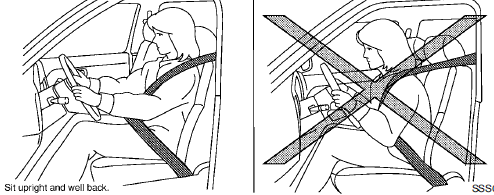
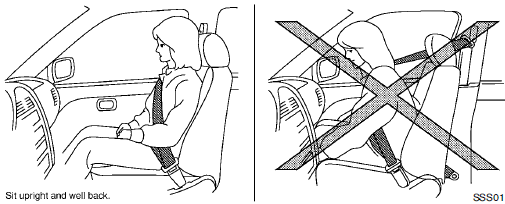
WARNING
• The front
air bags ordinarily will not
inflate in the event of a side impact,
rear impact, rollover, or lower severity
frontal collision. Always wear
your seat belts to help reduce the
risk or severity of injury in various
kinds of accidents.
• The front
passenger air bag will not
inflate if the passenger air bag
status light is lit or if the front
passenger seat is unoccupied. See
“Front passenger air bag and status
light” later in this section.
• The seat belts
and the front air bags
are most effective when you are
sitting well back and upright in the
seat with both feet on the floor. The
front air bags inflate with great
force. Even with the NISSAN Advanced
Air Bag System, if you are
unrestrained, leaning forward, sitting
sideways or out of position in
any way, you are at greater risk of
injury or death in a crash. You may
also receive serious or fatal injuries
from the front air bag if you are up
against it when it inflates. Always sit back against the
seatback and as
far-away as practical from the steering
wheel or instrument panel. Always
use the seat belts.
• The driver and
front passenger seat
belt buckles are equipped with
sensors that detect if the seat belts
are fastened. The Advanced Air Bag
System monitors the severity of a
collision and seat belt usage then
inflates the air bags as needed.
Failure to properly wear seat belts
can increase the risk or severity of
injury in an accident.
• The front
passenger seat is
equipped with an occupant classification
sensor (pattern sensor) that
turns the front passenger air bag
OFF under some conditions. This
sensor is only used in this seat.
Failure to be properly seated and
wearing the seat belt can increase
the risk or severity of injury in an
accident. See “Front passenger air
bag and status light” later in this
section.
• Keep hands on
the outside of the
steering wheel. Placing them inside
the steering wheel rim could increase
the risk that they are injured
if the front air bag inflates.
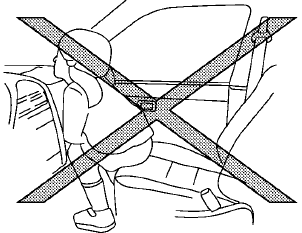
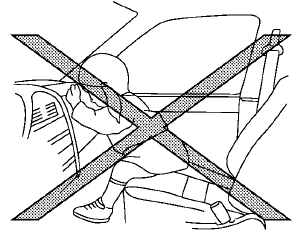
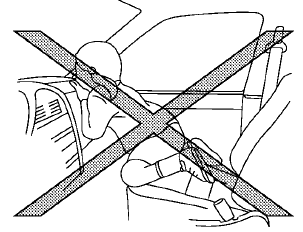
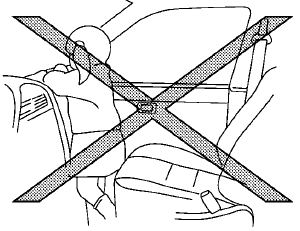
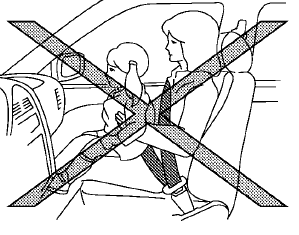
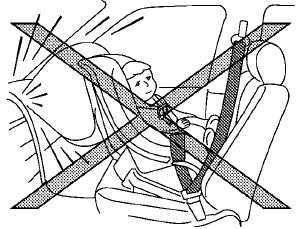
WARNING
• Never let
children ride unrestrained
or extend their hands or face out of
the window. Do not attempt to hold
them in your lap or arms. Some
examples of dangerous riding positions
are shown in the illustrations.
• Children may be
severely injured or
killed when the front air bags, side
air bags or curtain and rollover air
bags inflate if they are not properly
restrained. Pre-teens and children
should be properly restrained in the
rear seat, if possible.
• Even with the
NISSAN Advanced Air
Bag System, never install a rearfacing
child restraint in the front
seat. An inflating front air bag could
seriously injure or kill your child.
See “Child restraints” earlier in this section for details.
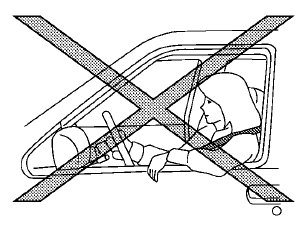
Do not lean against doors or windows.
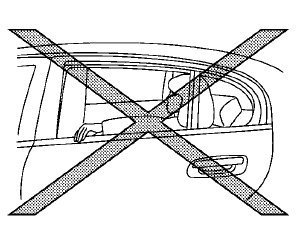
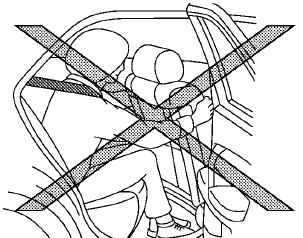
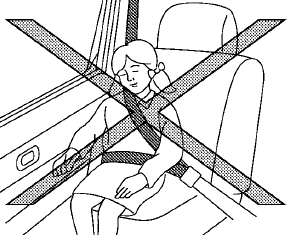
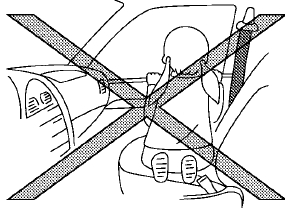
WARNING
Front seat-mounted side-impact supplemental air bags and roof-mounted curtain side-impact and rollover supplemental air bags (Hardtop models) or door-mounted curtain side-impact and rollover supplemental air bags (Cross- Cabriolet models):
• The side air bags and curtain air bags ordinarily will not inflate in the event of a frontal impact, rear impact or lower severity side collision.
Always wear your seat belts to help reduce the risk or
severity of injury
in various kinds of accidents.
• The seat belts
and air bags are most
effective when you are sitting well
back and upright in the seat with
both feet on the floor. The air bags
inflate with great force. Do not allow
anyone to place their hand, leg or
face near the side air bag on the
side of the seatback of the front
seat, near the side roof rails (Hardtop
models), or near the top of the
door finisher (CrossCabriolet models).
Do not allow anyone sitting in
the front seats or rear outboard
seats to extend their hand out of
the window or lean against the
door. Some examples of dangerous
riding positions are shown in the
previous illustrations.
• When sitting in
the rear seat, do not
hold onto the seatback of the front
seat. If the side air bag inflates, you
may be seriously injured. Be especially
careful with children, who
should always be properly restrained.
Some examples of dangerous
riding positions are shown in
the illustrations.
• Do not use
seat covers on the front
seatbacks. They may interfere with
side air bag inflation.
See also:
Driving safety precautions
Your NISSAN is designed for both normal and
off-road use. However, avoid driving in deep water
or mud as your NISSAN is mainly designed for
leisure use, unlike a conventional off-road vehicle.
R ...
Loading tips
● The GVW must not exceed GVWR
or GAWR as specified on the
F.M.V.S.S./C.M.V.S.S. certification
label.
● Do not load the front and rear axle to
the GAWR. Doing so will exceed the
GVWR ...
Lights
Headlights
1. Headlight (high-beam)
2. Front turn signal/park/side marker light
3. Front map light
4. Ceiling light
5. Front fog light
6. Headlight (low-beam)
7. High-mounted stop light
8. C ...
